Science
Fossil Discovery Reveals New Insights on Tenontosaurus Range

A recent discovery in West Texas has expanded the known geographical range of the dinosaur species known as Tenontosaurus. The fossils, dating back approximately 115 million years, were unearthed by Jason W. Ricketts, Ph.D., an associate professor at the University of Texas at El Paso (UTEP), while he was conducting unrelated research at the Indio Mountains Research Station.
Ricketts stumbled upon the fossils during a study of the region’s rock formations. “I wasn’t out looking for fossils that day,” Ricketts stated. “I was studying the rocks in the area when I noticed fragments weathering out of soft shale. There was no need to excavate—I simply picked them up.” This unexpected find has significant implications, as dinosaur fossil discoveries in this region are quite rare.
The research detailing this finding is published in a paper titled “An Ornithopod Dinosaur from the Lower Cretaceous of West Texas,” co-authored by Spencer G. Lucas, Ph.D., paleontology curator at the New Mexico Museum of Natural History and Science, and Sebastian G. Dalman, a doctoral student at Montana State University.
Significance of the Discovery
The fossil remains include individual fragments, with the largest piece identified as part of a femur leg bone. Despite being incomplete, Ricketts emphasized their scientific value. Prior to this discovery, fossils of Tenontosaurus had only been found in locations such as Montana, Idaho, Arizona, and other areas of Texas.
“This discovery extends the known range of Tenontosaurus farther southwest than previously documented,” Ricketts explained. “Until now, fossils of this species were known primarily from localities farther north and east, such as Utah and Wyoming. This finding shows that Tenontosaurus lived as far south as West Texas.”
The findings contribute valuable insights into how these dinosaurs dispersed across North America and adapted to varying environments during the Early Cretaceous period.
Future Exploration and Research
Liz Walsh, Ph.D., interim dean of the UTEP College of Science, praised the discovery, highlighting its importance in understanding the Earth’s history. “This find highlights the importance of fieldwork and the role of dedicated researchers like Dr. Ricketts in uncovering new chapters of Earth’s history,” Walsh remarked. “It’s also a reminder that major discoveries can happen when we least expect them.”
While the fossil fragments are still under study, Ricketts hopes this discovery will encourage further exploration in West Texas. “This finding shows that there’s still much to learn about our region’s prehistoric past,” he said. “It’s a privilege to contribute even a small piece to that bigger story.”
The research team anticipates that ongoing studies will continue to shed light on the significance of this remarkable discovery, opening new avenues for understanding the evolutionary history of dinosaurs in North America.
-

 Lifestyle3 months ago
Lifestyle3 months agoLibraries Challenge Rising E-Book Costs Amid Growing Demand
-

 Sports3 months ago
Sports3 months agoTyreek Hill Responds to Tua Tagovailoa’s Comments on Team Dynamics
-

 Sports3 months ago
Sports3 months agoLiverpool Secures Agreement to Sign Young Striker Will Wright
-

 Lifestyle3 months ago
Lifestyle3 months agoSave Your Split Tomatoes: Expert Tips for Gardeners
-

 Lifestyle3 months ago
Lifestyle3 months agoPrincess Beatrice’s Daughter Athena Joins Siblings at London Parade
-

 World3 months ago
World3 months agoWinter Storms Lash New South Wales with Snow, Flood Risks
-

 Science3 months ago
Science3 months agoTrump Administration Moves to Repeal Key Climate Regulation
-

 Science2 months ago
Science2 months agoSan Francisco Hosts Unique Contest to Identify “Performative Males”
-

 Business3 months ago
Business3 months agoSoFi Technologies Shares Slip 2% Following Insider Stock Sale
-

 Science3 months ago
Science3 months agoNew Tool Reveals Link Between Horse Coat Condition and Parasites
-

 Sports3 months ago
Sports3 months agoElon Musk Sculpture Travels From Utah to Yosemite National Park
-

 Science3 months ago
Science3 months agoNew Study Confirms Humans Transported Stonehenge Bluestones









